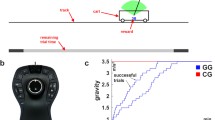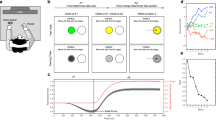Abstract
The human motor control system gracefully behaves in a dynamic and time varying environment. Here, we explored the predictive capabilities of the motor system in a simple motor task of lifting a series of virtual objects. When a subject lifts an object, she/he uses an expectation of the weight of the object to generate a motor command. All models of motor learning employ learning algorithms that essentially expect the future to be similar to the previously experienced environment. In this study, we asked subjects to lift a series of increasing weights and determined whether they extrapolated from past experience and predicted the next weight in the series even though that weight had never been experienced. The grip force at the beginning of the lifting task is a clean indication of the motor expectation. In contrast to the motor learning literature asserting adaptation by means of expecting a weighted average based on past experience, our results suggest that the motor system is able to predict the subsequent weight that follows a series of increasing weights.






Similar content being viewed by others
References
Ariff G, Donchin O, Nanayakkara T, Shadmehr R (2002) A real-time state predictor in motor control: study of saccadic eye movements during unseen reaching movements. J Neurosci 22:7721–7729
Botzer L, Karniel A (2009) A simple and accurate onset detection method for a measured bell-shaped speed profile. Front Neurosci 3:61. doi:10.3389/neuro.20.002.2009
Bracewell RM, Wing AM, Soper HM, Clark KG (2003) Predictive and reactive co-ordination of grip and load forces in bimanual lifting in man. Eur J Neurosci 18:2396–2402
Brashers-Krug T, Shadmehr R, Bizzi E (1996) Consolidation in human motor memory. Nature 382:252–255
Conditt MA, Mussa-Ivaldi FA (1999) Central representation of time during motor learning. Proc Natl Acad Sci USA 96:11625–11630
Davidson PR, Wolpert D (2003) Motor learning and prediction in a variable environment. Curr Opin Neurobiol 13:1–6
Dudai Y, Carruthers M (2005) The Janus face of Mnemosyne. Nature 434:823–824
Dudai Y, Eisenberg M (2004) Rites of passage of the engram: reconsolidation and the lingering consolidation hypothesis. Neuron 44:93–100
Flanagan JR, Lolley S (2001) The inertial anisotropy of the arm is accurately predicted during movement planning. J Neurosci 21:1361–1369
Flanagan JR, Wing AM (1997) The role of internal models in motion planning and control: evidence from grip force adjustments during movements of hand-held loads. J Neurosci 17(4):1519–1528
Foisy M, Feldman A (2006) Threshold control of arm posture and movement adaptation to load. Exp Brain Res 175:726–744
Gilbert DT, Wilson TD (2007) Prospection: experiencing the future. Science 317:1351–1354
Gribble PL, Ostry DJ (2000) Compensation for loads during arm movements using equilibrium-point control. Exp Brain Res 135:474–482
Johansson RS, Cole KJ (1992) Sensory-motor coordination during grasping and manipulative actions. Curr Opin Neurobiol 2:815–823
Jordan MI (1996) Computational aspects of motor control and motor learning. In: Heuer H, Keele S (eds) Handbook of perception and action motor skills. Academic Press, New York
Karniel A (2002) Three creatures named ‘forward model’. Neural Netw 15:305–307
Karniel A, Ben-Itzhak S (2008) Minimum acceleration criterion with constraints. Neural Comput 20(3):779–812
Karniel A, Mussa-Ivaldi FA (2003) Does the motor control system use multiple models and context switching to cope with a variable environment? Exp Brain Res 143:520–524
Kawato M (1999) Internal models for motor control and trajectory planning. Curr Opin Neurobiol 9:718–727
Krakauer JW, Shadmehr R (2006) Consolidation of motor memory. Trends Neurosci 29(1):58–64
Schacter DL, Addis DR (2007) The cognitive neuroscience of constructive memory: remembering the past and imagining the future. Phil Trans R Soc B 362:773–786
Scheidt RA, Dingwell JB, Mussa-Ivaldi FA (2001) Learning to move amid uncertainty. J Neurophysiol 86:971–985
Smith MA, Ghazizadeh A, Shadmehr R (2006) Interacting adaptive processes with different timescale underlie short-term motor learning. PLoS Biol 4:e179
Takahashi CD, Scheidt RA, Reinkensmeyer DJ (2001) Impedance control and internal model formation when reaching in a randomly varying dynamical environment. J Neurophysiol 86:1047–1051
Thoroughman KA, Shadmehr R (2000) Learning of action through adaptive combination of motor primitives. Nature 407:742–747
Witney AG, Vetter P, Wolpert DM (2001) The influence of previous experience on predictive motor control. Neuroreport 12:649–653
Wolpert DM, Kawato M (1998) Multiple paired forward and inverse models for motor control. Neural Netw 11:1317–1329
Acknowledgments
The computational motor control laboratory is supported by the National Institute for Psychobiology in Israel; the Ministry of Science, Culture and Sport, Israel, the United States—Israel Bi-National Science Foundation (BSF), Jerusalem, Israel; and the National Science Foundation (ISF), Israel.
Author information
Authors and Affiliations
Corresponding author
Rights and permissions
About this article
Cite this article
Mawase, F., Karniel, A. Evidence for predictive control in lifting series of virtual objects. Exp Brain Res 203, 447–452 (2010). https://doi.org/10.1007/s00221-010-2249-8
Received:
Accepted:
Published:
Issue Date:
DOI: https://doi.org/10.1007/s00221-010-2249-8




